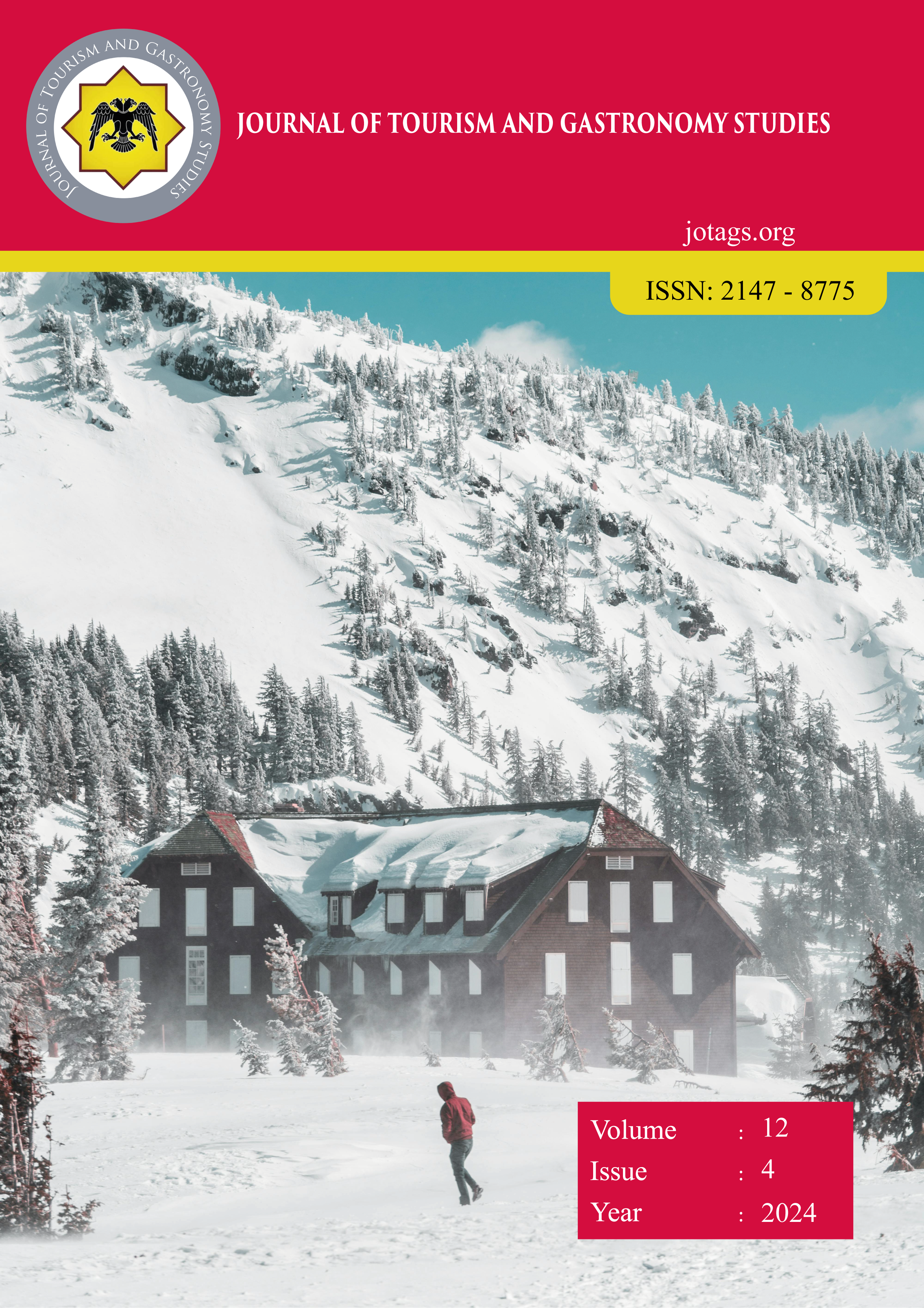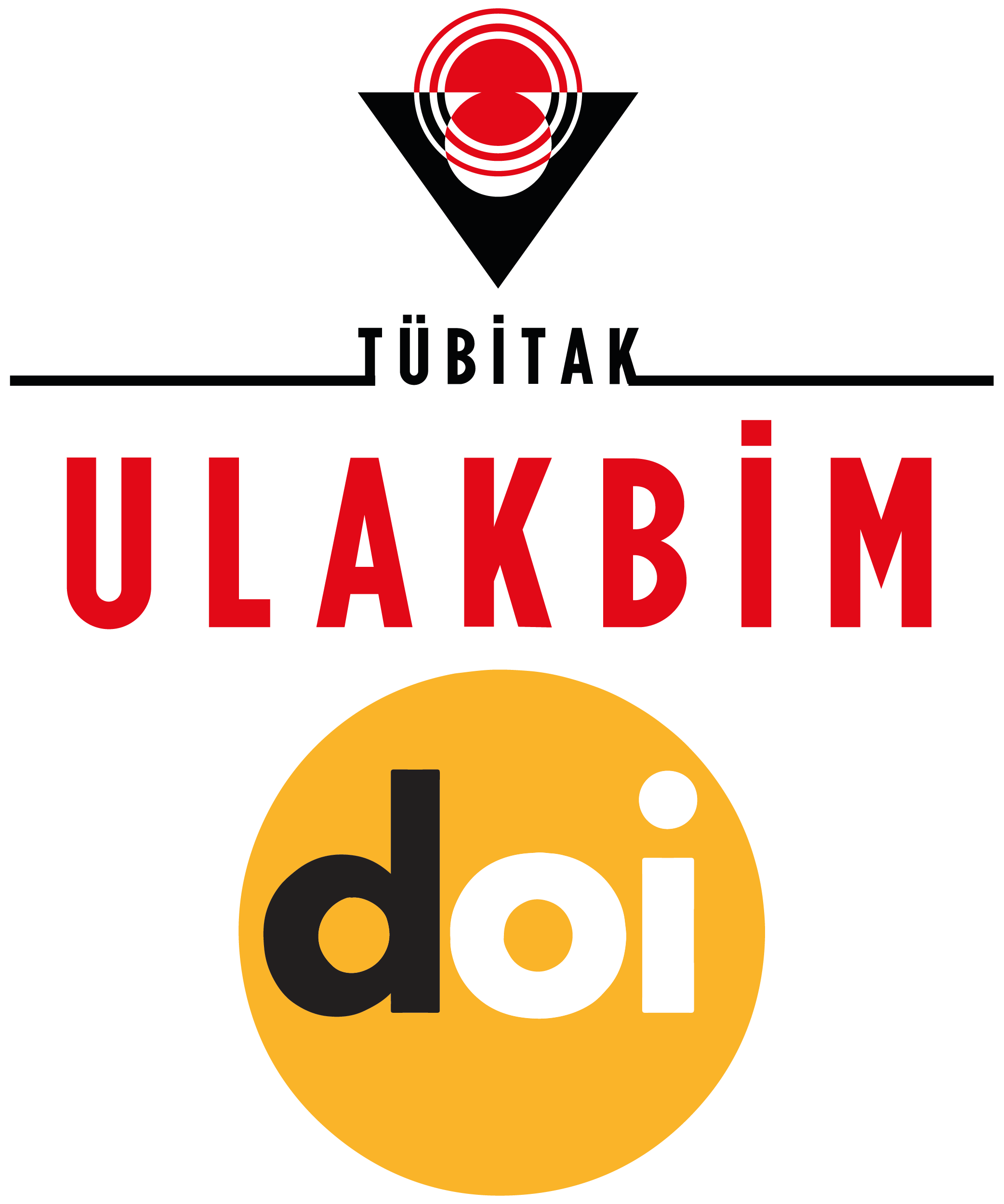Gastronominin Duygusal Bileşenleri Ölçeği’nin Türkçe’ye Uyarlama Çalışması (The Turkish Adaptation of the Affective Components of Gastronomy Scale)
DOI:
https://doi.org/10.21325/jotags.2024.1520Keywords:
Gastronomy, Affective components of gastronomy, Scale adaptationAbstract
Gastronomy has become one of the most important elements of tourism and has found a place in the top ranks among the travel motivations of tourists. In this context, it is very important to determine the feelings and emotions arising from a tourist's gastronomy experiences. The purpose of this research is to adapt the Affective Components of Gastronomy Scale, which has been developed in English, into Turkish and to conduct validity and reliability analyses. In line with this aim, translation and back-translation studies were conducted by English language experts and tourism academicians, followed by a pilot study, exploratory factor analysis, and confirmatory factor analysis to finalize the scale. The Turkish adaptation of the scale consists of four items and one dimension. As a result of the analyses, the scale was found to be unproblematic in terms of Cronbach's Alpha value and factor loadings. As a result of confirmatory factor analysis, all of the goodness-of-fit values showed perfect fit. The AVE and CR values of the scale were also above the accepted threshold value. In line with these results, it was revealed that the Affective Components of Gastronomy Scale adapted into Turkish is a valid and reliable measurement tool.
References
Akgündüz, Y., & Şanlı, C. (2016). İşgören Avukatlığı ölçeğinin turizm işletmeleri örnekleminde Türkçeye uyarlama çalışması. Journal of Tourism & Gastronomy Studies, 4(Special Issue 1), 282-292.
Bagozzi, R. P., & Yi, Y. (1988). On the evaluation of structural equation models. Journal of the Academy of Marketing Science, 16(1), 74-94. https://doi.org/10.1007/BF02723327
Bastiaansen, M., Lub, X. D., Mitas, O., Jung, T. H., Ascenção, M. P., Han, D.-I., … Strijbosch, W. (2019). Emotions as core building blocks of an experience. International Journal of Contemporary Hospitality Management, 31(2), 651-668. https://doi.org/10.1108/IJCHM-11-2017-0761
Bentler, P. M., & Bonett, D. G. (1980). Significance tests and goodness of fit in the analysis of covariance structures. Psychological Bulletin, 88(3), 588-606. https://doi.org/10.1037/0033-2909.88.3.588
Björk, P., & Kauppinen-Räisänen, H. (2016). Exploring the multi-dimensionality of travellers’ culinary-gastronomic experiences. Current Issues in Tourism, 19(12), 1260-1280. https://doi.org/10.1080/13683500.2013.868412
Cattell, R. (1978). The Scientific Use of Factor Analysis. New York, NY: Plenum.
Desmet, P. M. A., & Schifferstein, H. N. J. (2008). Sources of positive and negative emotions in food experience. Appetite, 50(2-3), 290-301. https://doi.org/10.1016/j.appet.2007.08.003
Everitt, B. S. (1975). Multivariate analysis: The need for data, and other problems. The British Journal of Psychiatry, 126(3), 237-240. https://doi.org/10.1192/bjp.126.3.237
Fetscherin, M., & Stephano, R.-M. (2016). The medical tourism index: Scale development and validation. Tourism Management, 52, 539-556. https://doi.org/10.1016/j.tourman.2015.08.010
Fornell, C., & Larcker, D. F. (1981). Evaluating structural equation models with unobservable variables and measurement error. Journal of Marketing Research, 18(1), 39-50. https://doi.org/10.1177/002224378101800104
George, D. (2011). SPSS for windows step by step: A simple study guide and reference, 17.0 update, 10/e. India: Pearson Education.
Gi̇rgi̇n, G. K., Sökmen, C., & Sökmen, S. (2022). Uluslararası Turlarda gastronomik ürünler ve gastronomi deneyimi: TUI ve Thomas Cook örneklerinde ortak deneyim yaratımı (Gastronomic products and gastronomy experience in the ınternational tours: Co-creation experience in TUI and Thomas Cook examples). Journal of Tourism & Gastronomy Studies, 10(3), 10.21325/jotags.2022.1103-10.21325/jotags.2022.1103. https://doi.org/10.21325/jotags.2022.1103
Gorsuch, R. (1983). Factor Analysis (2nd Edition). Hillsdale, NJ: Lawrence Erlbaum Associates.
Hair, J. F., Risher, J. J., Sarstedt, M., & Ringle, C. M. (2019). When to use and how to report the results of PLS-SEM. European Business Review, 31(1), 2-24. https://doi.org/10.1108/EBR-11-2018-0203
Holbrook, M. B., & Hirschman, E. C. (1982). The experiential aspects of consumption: Consumer fantasies, feelings, and fun. Journal of Consumer Research, 9(2), 132-140. https://doi.org/10.1086/208906
Hsu, F.-C., Liu, J., & Lin, H. (2022). Affective components of gastronomy tourism: Measurement scale development and validation. International Journal of Contemporary Hospitality Management, 34(9), 3278-3299. https://doi.org/10.1108/IJCHM-09-2021-1112
Hu, L., & Bentler, P. M. (1999). Cutoff criteria for fit indexes in covariance structure analysis: Conventional criteria versus new alternatives. Structural Equation Modeling: A Multidisciplinary Journal, 6(1), 1-55. https://doi.org/10.1080/10705519909540118
Hurley, A. E., Scandura, T. A., Schriesheim, C. A., Brannick, M. T., Seers, A., Vandenberg, R. J., & Williams, L. J. (1997). Exploratory and Confirmatory Factor Analysis: Guidelines, Issues, and Alternatives. Journal of Organizational Behavior, 18(6), 667-683.
International Test Commission. (2017). ITC Guidelines for Translating and Adapting Tests (Second Edition). International Test Commission. Geliş tarihi gönderen https://www.intestcom.org/
Kaçar, B., & Yarış, A. (2022). Gastronomi deneyimi unsurlarının tekrar ziyaret niyetine etkisi (The efect of gastronomy experience elements on revisit intention). Journal of Tourism & Gastronomy Studies, 10(3), 2713-2734. https://doi.org/10.21325/jotags.2022.1112
Kaiser, H. F. (1970). A second generation little jiffy. Psychometrika, 35(4), 401-415. https://doi.org/10.1007/BF02291817
Kalaycı, Ş. (2010). SPSS Uygulamalı Çok Değişkenli İstatistik Teknikleri. Ankara: Asil Yayın Dağıtım.
Karaçam, Z. (2019). Ölçme araçlarının Türkçeye uyarlanması. Ebelik ve Sağlık Bilimleri Dergisi, 2(1), 28-37.
Karamustafa, K., Birdir, K., & Kiliçhan, R. (2016). Gastronomik akımlar çerçevesinde gıda tüketim ölçeği. Tüketici ve Tüketim Araştırmaları Dergisi (Journal of Consumer and Consumption Research), 8(2), 29.
Katırcıoğlu, E. (2023). Keşfedici merak ölçeğinin Türkçeye uyarlanması: Motosikletli Turistler üzerine bir araştırma. Güncel Turizm Araştırmaları Dergisi, 7(2), 509-529. https://doi.org/10.32572/guntad.1272323
Kauppinen‐Räisänen, H., Gummerus, J., & Lehtola, K. (2013). Remembered eating experiences described by the self, place, food, context and time. British Food Journal, 115(5), 666-685. https://doi.org/10.1108/00070701311331571
Kivela, J., & Crotts, J. C. (2006). Tourism and gastronomy: Gastronomy’s influence on how tourists experience a destination. Journal of Hospitality & Tourism Research, 30(3), 354-377. https://doi.org/10.1177/1096348006286797
Kline, P. (1979). Psychometrics and Psychology. London: Academic Press. Geliş tarihi gönderen https://cir.nii.ac.jp/crid/1130282272786224512
Lan, L. W., Wu, W.-W., & Lee, Y.-T. (2012). Promoting food tourism with kansei cuisine design. Procedia - Social and Behavioral Sciences, 40, 609-615. https://doi.org/10.1016/j.sbspro.2012.03.238
Lo, B. (2016). Global Phenomenon & Behaviour: “Camera Eats First” – Appetites. Geliş tarihi 27 Şubat 2024, gönderen https://appetitesblog.wordpress.com/2016/10/28/global-phenomenon-behaviour-camera-eats-first/
Nunnally, J. C. (1978). An Overview of Psychological Measurement. Içinde B. B. Wolman (Ed.), Clinical Diagnosis of Mental Disorders: A Handbook (ss. 97-146). Boston, MA: Springer US. https://doi.org/10.1007/978-1-4684-2490-4_4
Okumus, B. (2020). Food tourism research: A perspective article. Tourism Review, 76(1), 38-42. https://doi.org/10.1108/TR-11-2019-0450
Okumus, B., Koseoglu, M. A., & Ma, F. (2018). Food and gastronomy research in tourism and hospitality: A bibliometric analysis. International Journal of Hospitality Management, 73, 64-74. https://doi.org/10.1016/j.ijhm.2018.01.020
Polat, M. (2023). The impact of affective gastronomy experience on satisfaction and revisit ıntention: Evidence from Turkey. Journal of Tourism & Gastronomy Studies, 11(3), 2187-2202. https://doi.org/10.21325/jotags.2023.1288
Şahin, A., & Kılıçlar, A. (2022). The effect of tourists’ gastronomic experience on emotional and cognitive evaluation: An application of S-O-R paradigm. Journal of Hospitality and Tourism Insights, ahead-of-print, 1-18. https://doi.org/10.1108/JHTI-09-2021-0253
Tabachnick, B. G., Fidell, L. S., & Ullman, J. B. (2019). Using Multivariate Statistics (Seventh edition). New York: Pearson.
Vapur, M., & Sevi̇n, H. D. (2021). Boş zaman tatmin ölçeğinin türkçe formunun güvenirlik ve geçerlilik çalışması (Reliability and validity study of the Turkish form of the leisure satisfaction scale). Journal of Tourism & Gastronomy Studies, 9(1), 409-425. https://doi.org/10.21325/jotags.2021.796
Downloads
Published
How to Cite
Issue
Section
License
Copyright (c) 2024 Journal of Tourism & Gastronomy Studies

This work is licensed under a Creative Commons Attribution-NonCommercial 4.0 International License.








